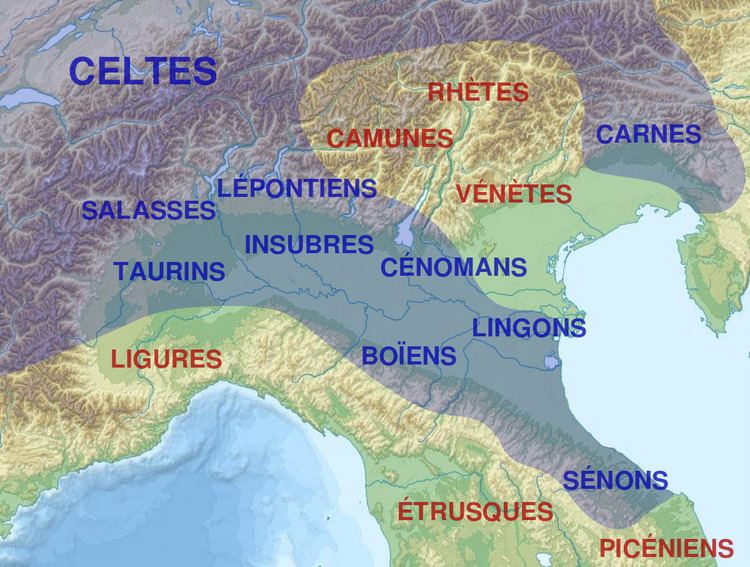 | ||
The Ligures (singular Ligus or Ligur; English: Ligurians, Greek: Λίγυες) were an ancient Indo-European people who appear to have originated in, and gave their name to, Liguria, a region of north-western Italy. Elements of the Ligures appear to have migrated to other areas of western Europe, including the Iberian peninsula
Contents
Little is known of the Old Ligurian language. It is generally believed to have been an Indo-European language with particularly strong Celtic affinities, as well as similarities to Italic languages. Only some proper names have survived, such as the desinence (inflectional suffix) -asca or -asco "village".
Because of the strong Celtic influences on their language and culture, they were known already in antiquity as Celto-Ligurians (in Greek Κελτολίγυες Keltolígues).
History
According to Plutarch, the Ligurians called themselves Ambrones, which could indicate a relationship with the Ambrones of northern Europe.
Strabo tells us they were of a different race from the Celts (by which he means Gauls), who inhabited the rest of the Alps, though they resembled them in their mode of life.
Aeschylus represents Hercules as contending with the Ligures on the stony plains, near the mouths of the Rhone, and Herodotus speaks of Ligures inhabiting the country above Massilia (modern Marseilles, founded by the Greeks).
Thucydides also speaks of the Ligures having expelled the Sicanians, an Iberian tribe, from the banks of the river Sicanus, in Iberia.
The Periplus of Pseudo-Scylax describes the Ligyes (Ligures) as living along the Mediterranean coast from Antion (Antibes) as far as the mouth of the Rhone; then intermingled with the Iberians from the Rhone to Emporion in Spain.
The Ligures seem to have been ready to engage as mercenary troops in the service of others. Ligurian auxiliaries are mentioned in the army of the Carthaginian general Hamilcar in 480 BC. Greek leaders in Sicily continued to recruit their mercenary forces from the same quarter as late as the time of Agathocles.
The Ligures fought long and hard against the Romans, but as a result of these hostilities many were displaced from their homeland and eventually assimilated into Roman culture during the 2nd century BC. Roman sources describe the Ligurians as smaller framed than the Gauls, but physically stronger, more ferocious and fiercer as warriors, hence their reputation as mercenary troops.
Lucan in his Pharsalia (c. 61 AD) described Ligurian tribes as being long-haired, and their hair a shade of auburn (a reddish-brown):
...Ligurian tribes, now shorn, in ancient days
First of the long-haired nations, on whose necks
Once flowed the auburn locks in pride supreme.
People with Ligurian names were living south of Placentia, in Italy, as late as 102 AD.
Modern theories regarding the Ligures' origins
Traditional accounts suggested that the Ligures represented the northern branch of a ethno-linguistic layer older than, and very different to, the proto-Italic peoples. It was widely believed that that a "Ligurian-Sicanian" culture occupied an wide area of southern Europe, stretching from Liguria to Sicily and Iberia. However, while any such area would be broadly similar to that of the paleo-European "Tyrrhenian culture" hypothetised by later modern scholars, there are no known links between the Tyrrenians and Ligurians.
In the 19th century, the origins of the Ligures drew renewed attention from scholars. Amédée Thierry, a French historian, linked them to the Iberians, while Karl Müllenhoff, professor of Germanic antiquities at the Universities of Kiel and Berlin, studying the sources of the Ora maritima by Avienus (a Latin poet who lived in the 4th century AD, but who used as a source for his own work a Phoenician Periplum of the 6th century BC), held that the name 'Ligurians' generically referred to various peoples who lived in Western Europe, including the Celts, but thought the "real Ligurians" were a Pre-Indo-European population.
Arturo Issel, a Genoese geologist and paleontologist, considered Liurians as being direct descendants of the Cro-Magnon men which lived throughout Gaul from the Mesolithic period.
Dominique-François-Louis Roget, Baron de Belloguet, claimed a "Gallic" origin of the Ligurians. During the Iron Age the spoken language, the main divinities and the workmanship of the artifacts unearthed in the area of Liguria (see the many torcs) were similar to that of Celtic in style and type.
Those in favor of an Indo-European origin included Henri d'Arbois de Jubainville, a 19th-century French historian, who argued the Ligurians were the earliest Indo-European speakers of the Western Europe. Jubainville's "Celto-Ligurian hypothesis", as it latter became known, was significantly expanded in the second edition of his initial study. It inspired a body of contemporary philological research, as well as some archaeological work. The Celto-Ligurian hypothesis became associated with the Funnelbeaker culture and "expanded to cover much of Central Europe".
Julius Pokorny adapted the Celto-Ligurian hypothesis into one linking the Ligures to the Illyrians, citing an array of similar evidence from Eastern Europe. Under this theory the "Ligures-Illyrians" became associated with the prehistoric Urnfield peoples.
Tribes
Numerous tribes of Ligures are mentioned by ancient historians, among them:
In the island of Corsica and far northeast Sardinia dwelt a group of tribes called Corsi, although they are classified as nuragic tribes (that may have been related to the Iberians, the Aquitanians or to the Etruscans) they also may have been a group of ligurian tribes, like the Ilvates in the neighboring Ilva (Elba) island (nuragic tribes, in Corsica and Sardinia, were not necessarily from the same ethnic origin or spoke the same language):
